Tillandsia rosacea
Click thumbnails for full size, scaled to a new window.
Tillandsia rosacea
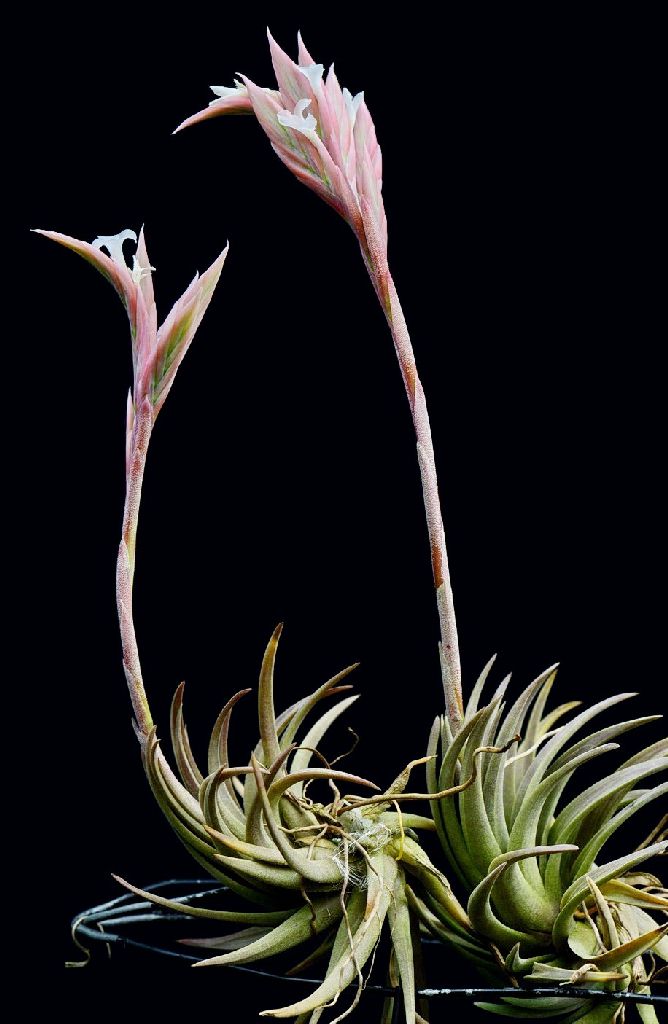
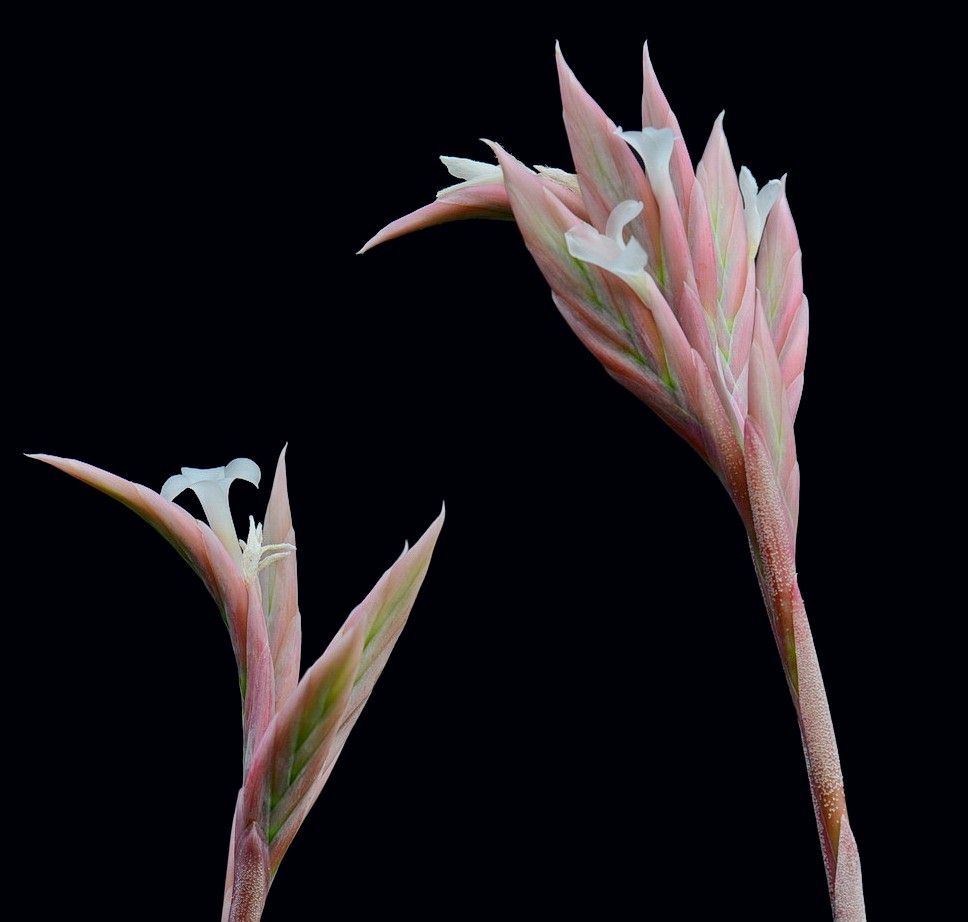
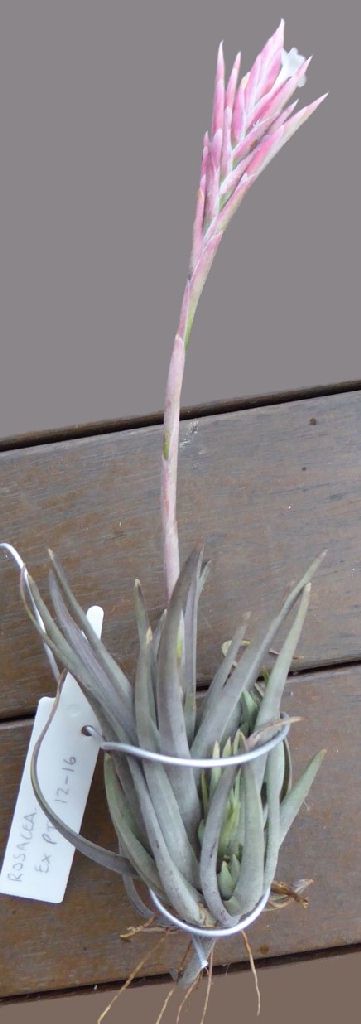
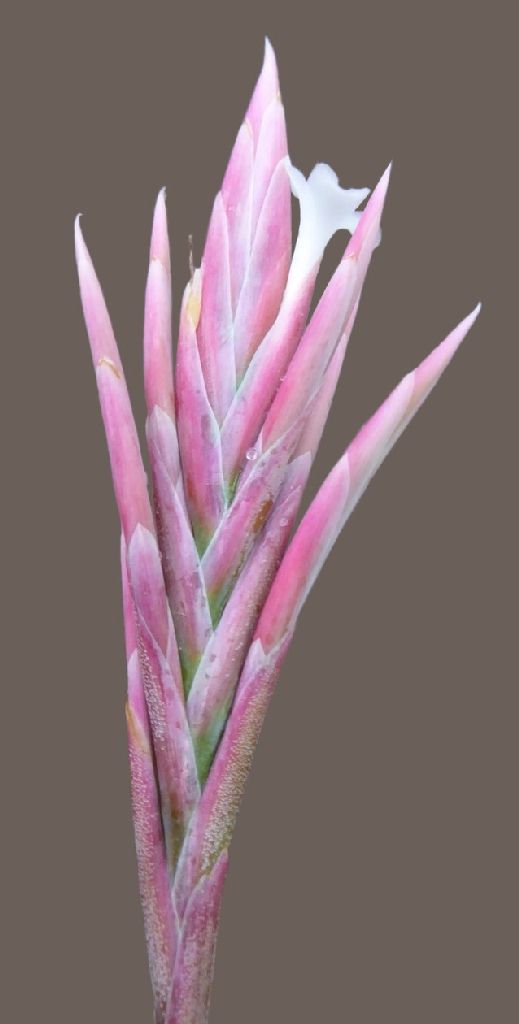
| Peter Tristram 01/15 |
Bruce Dunstan 12/18 |
Peter Tristram ... "This little, slow-growing delight was sourced at Lotte’s in Austria and bloomed a year or so ago but not posted. The attempted crossing with T. globosa set viable seed."
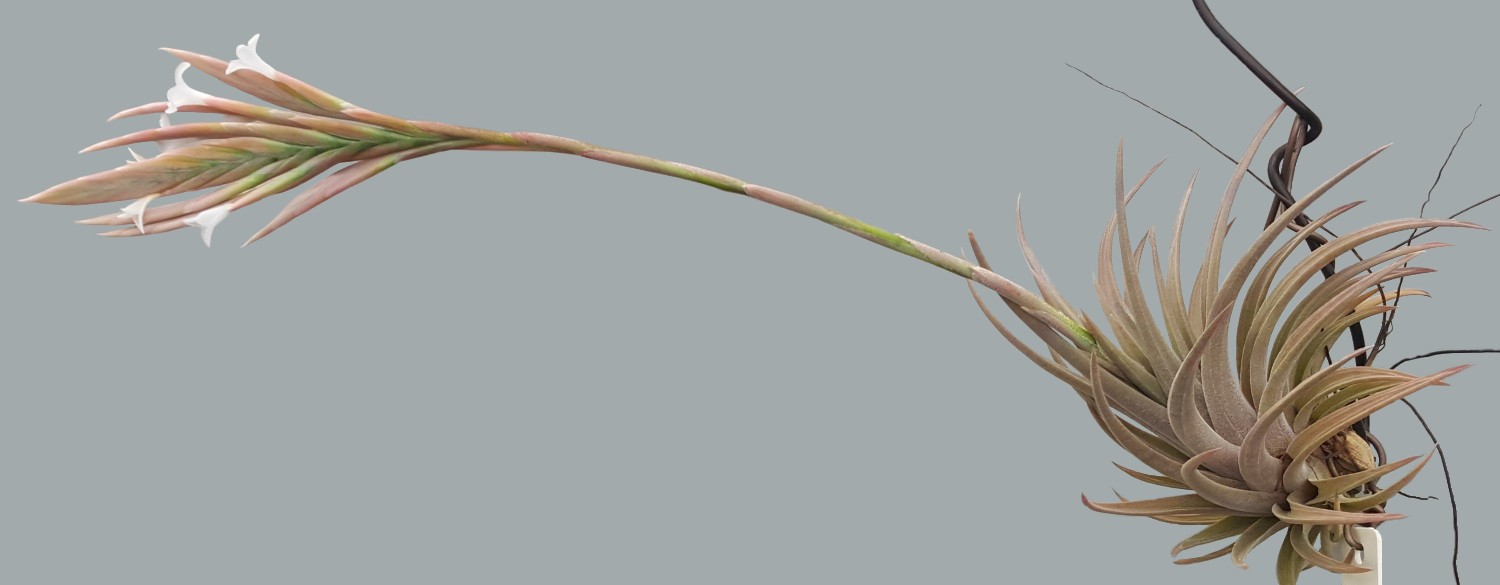
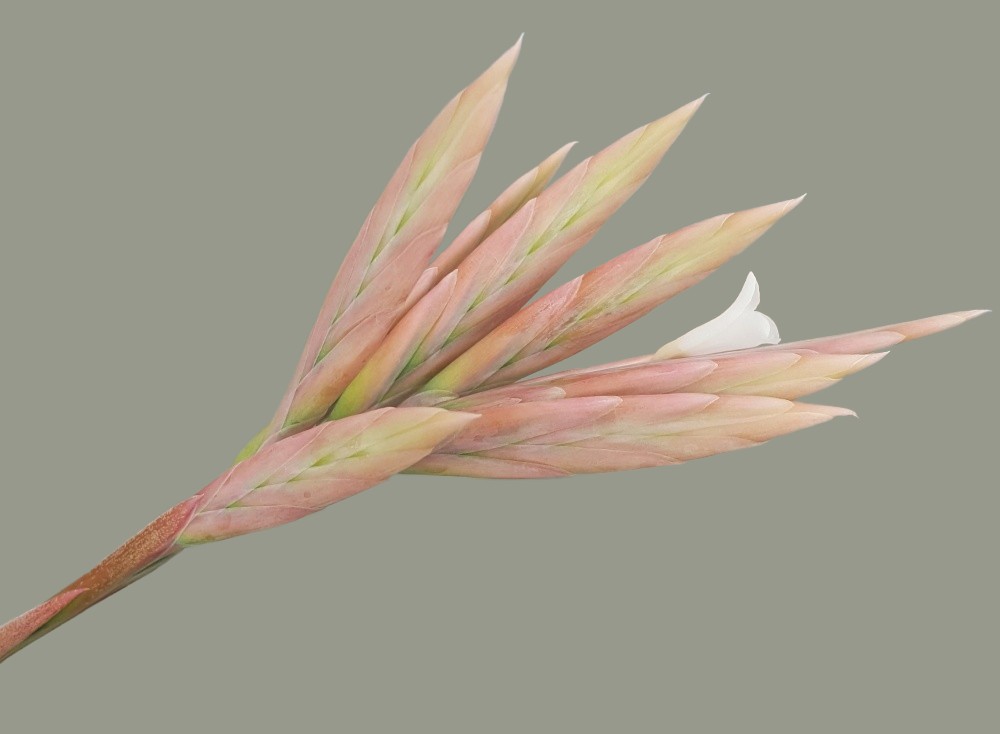
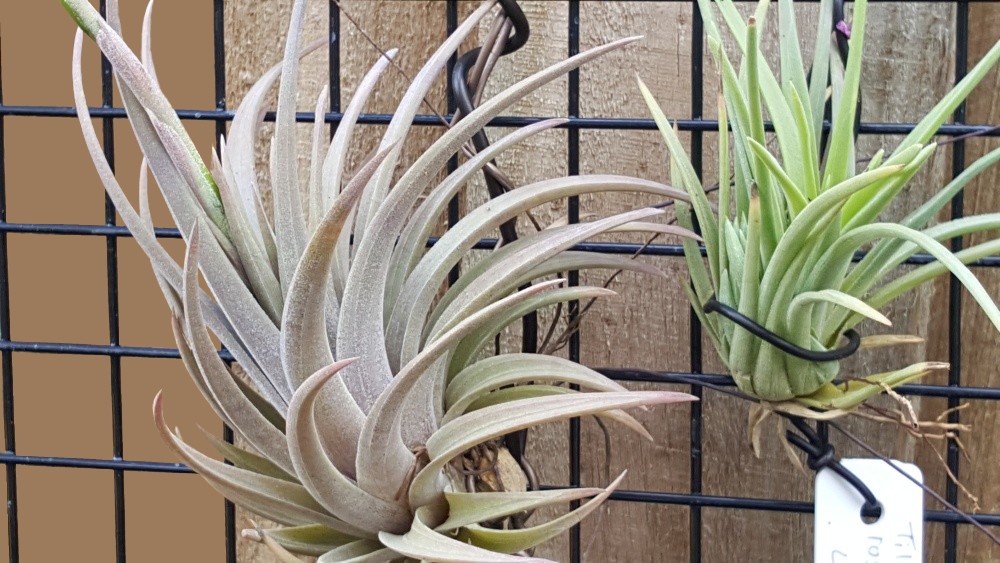
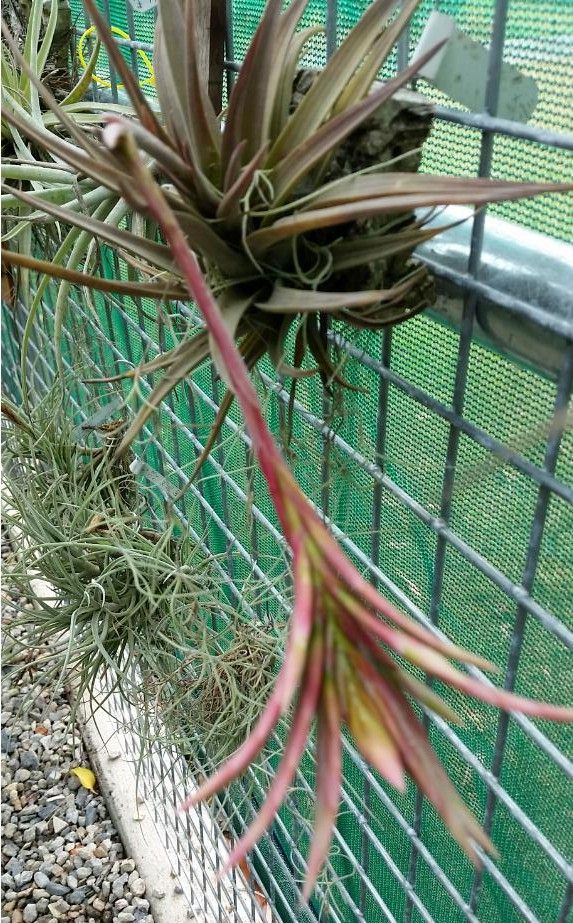
| Chris Larson 11/17 (2x larger form + comparison with smaller as per P.Tristram) |
Pam Butler 12/18 |
Chris Larson ... "Very pretty plant from 450m alt. in Bolivia. The first 2 are of a larger form with more obvious trichomes that I have not flowered before.
The 3rd photo is a comparative photo of the 2 forms I have. The more common smaller plant with less trichomes is on the right, the same as Peter Tristram's photos above..
When I looked at the Till disc when I flowered the smaller form a few times, I thought that the comparison with T. didisticha was a bit of a stretch. However, it is more obvious with the form currently in flower."
Pam Butler ... "Bruce Dunstan: Where are you growing this? Mine is much more colourful although no flowers yet. It has had an inflorescence for a couple of months."
Bruce Dunstan ... "This one gets full sun till lunchtime then shade. The spike in the images gets the sun exposure. The underside to the spike in the shade is much paler.
Post an image of yours when you get it flowering to compare. I have a smaller greener clone as well but still waiting on that one to flower."
Peter Tristram ... "I’m not sure if anyone else has imported this species but I have 3 or 4 clones which vary in size and colour, obtained over a few trips to Europe so Pam might have a different one. It’s a delightful, smallish species with quite succulent leaves and it clumps nicely too."
Pam Butler ... "This is my plant. The inflorescence is bent as it had plants above. It is one from Peter Tristram."
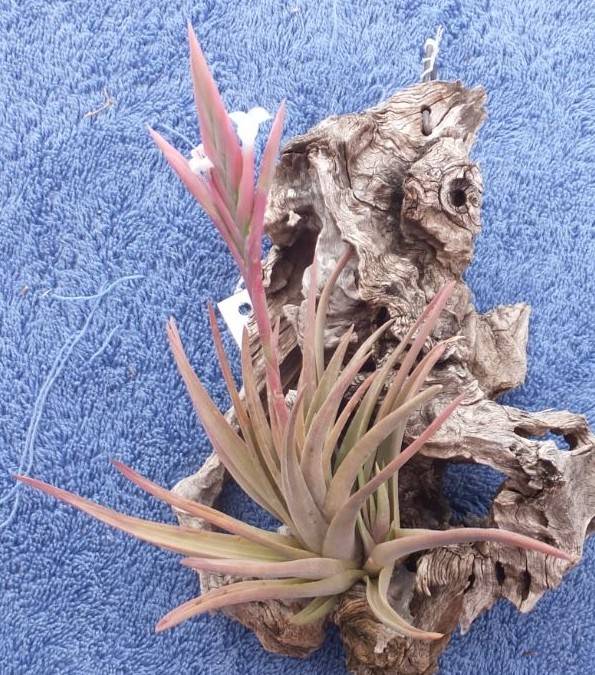
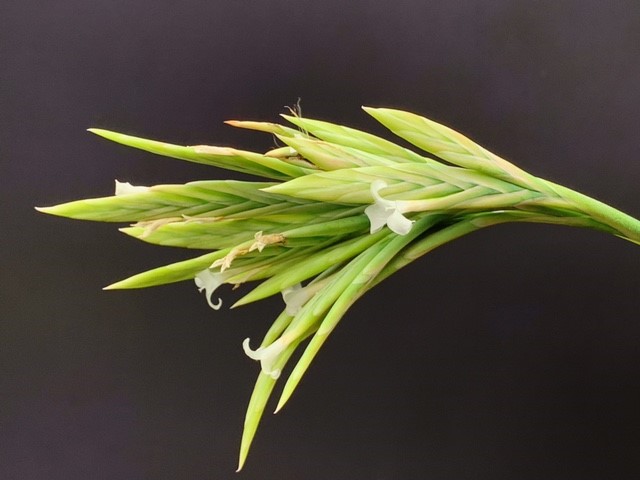
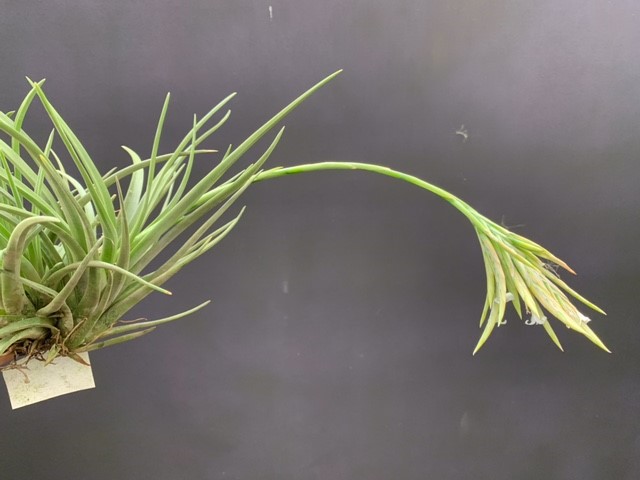
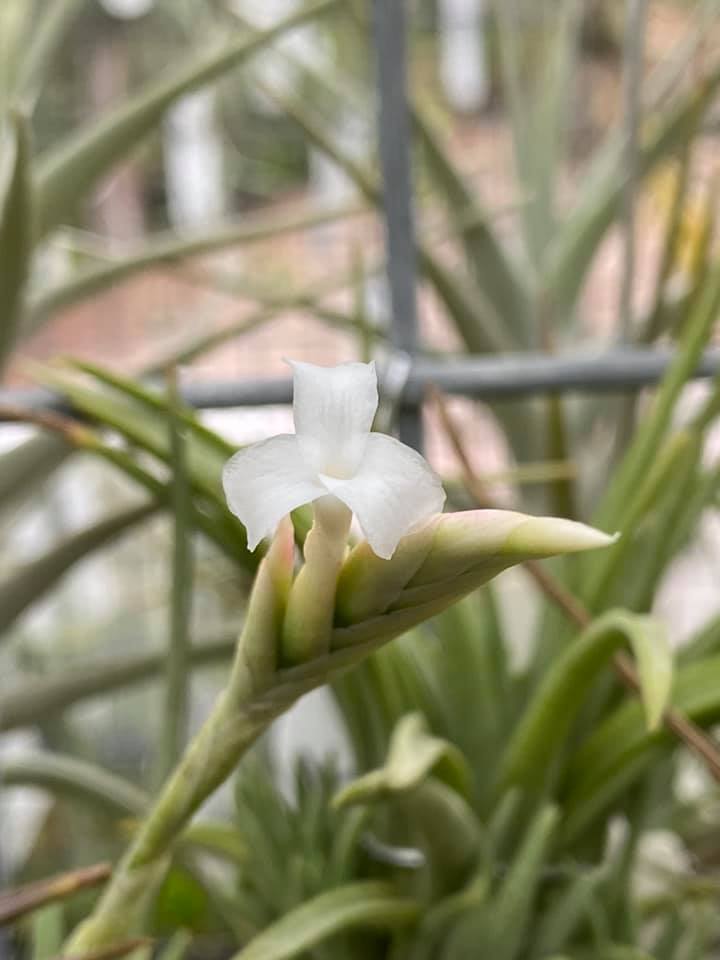
| Adam Bodzioch 12/20 as rosacea 'Silver' |
Peter Tristram 12/20 |
Dale Dixon 02/21 |
Adam Bodzioch ... "First flowering for me of this attractive smaller Tillandsia. I got this one from Peter Tristram (Ex LH on my label which I presume means that Peter got it from Lydia Hromadnik)."
Peter Tristram ... "Hi Adam, lovely little species! I don't remember the 'silver' bit though.
Chris and I have a few forms that I obtained from various collections in Europe, many misnamed so probably in the collection since before the species was described. The one you have, ex Lotte, is very attractive. Lotte Hromadnik is busy publishing new descriptions again, which is good to see. These are in Die Bromelie."
Peter Tristram ... "I just found a large form of T. rosacea in full bloom. It's literally about 3 x the size of Adam's though lacks the colour."
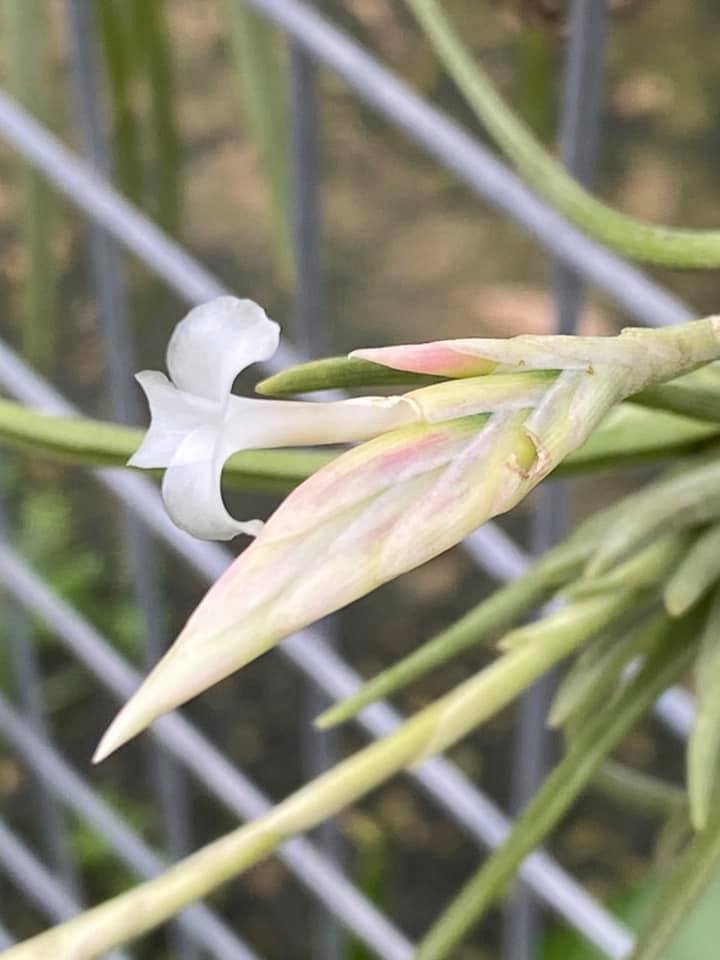
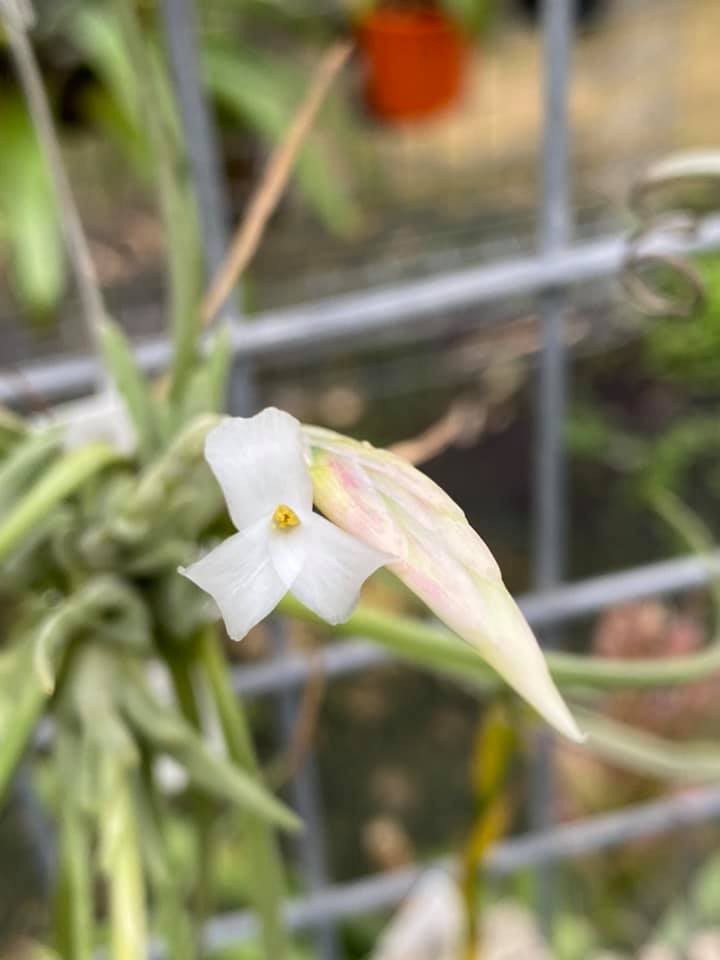
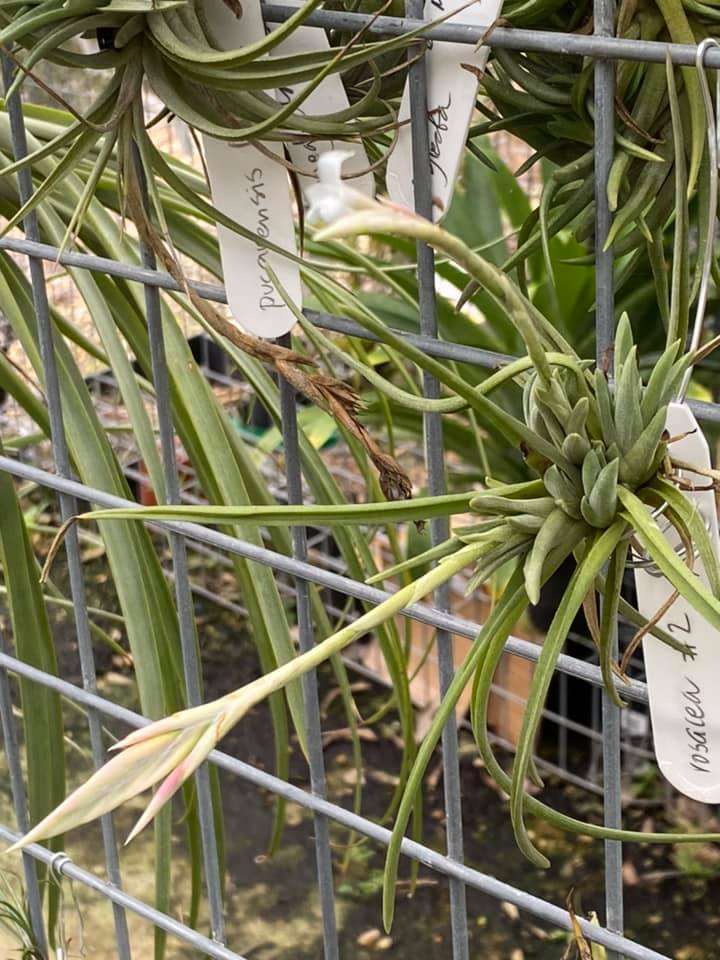
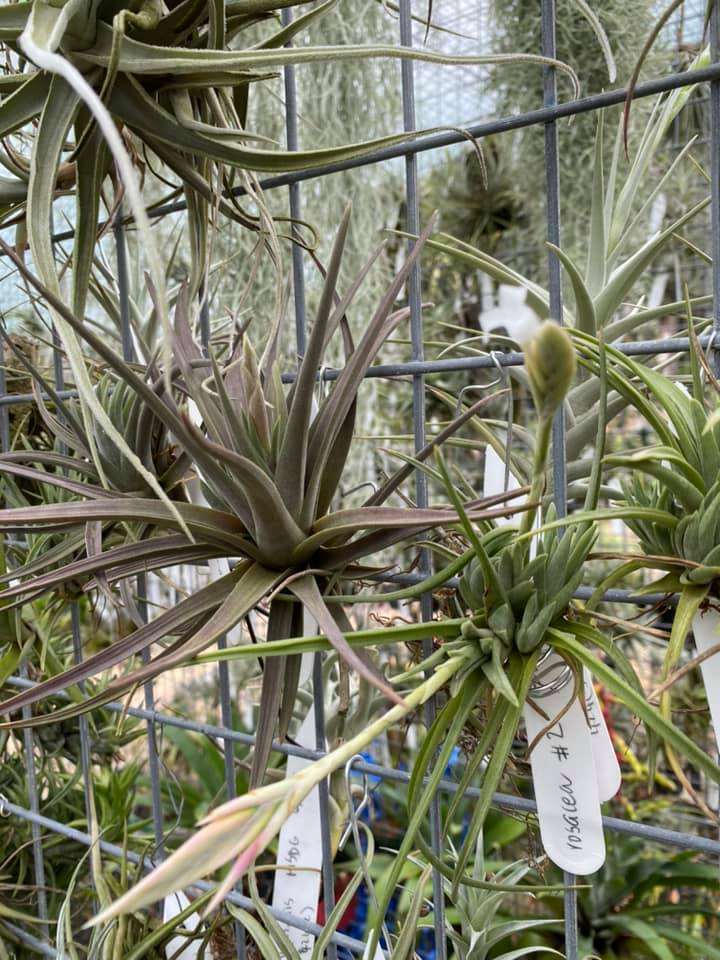
| Dale Dixon 02/21 |
Dale Dixon 02/21 Two forms |
Dale Dixon ... "The epithet ‘rosacea’ is Latin for rose coloured and in this case applies to the pinkish floral bracts of the inflorescence.
I have two forms of this species. They are primarily differentiated by size and leaf colour. The last image shows the large red-leaf form adjacent to the smaller green-leaf form.
I was hoping that the floral bracts would colour up a bit more given the name. It may be that the light intensity I am providing them is not strong enough as I have them sheltered on a south facing wall. I will experiment with different growing positions in the #TillHouse to see if this influences the bract colour intensity. I note that some collectors are providing their plants with full sun. The larger red-leaf form is also coming into flower so I will watch with interest how the inflorescence colours up.
This species pups freely for me, even before flowering. The two inflorescences on this plant have initiated from immature pups."
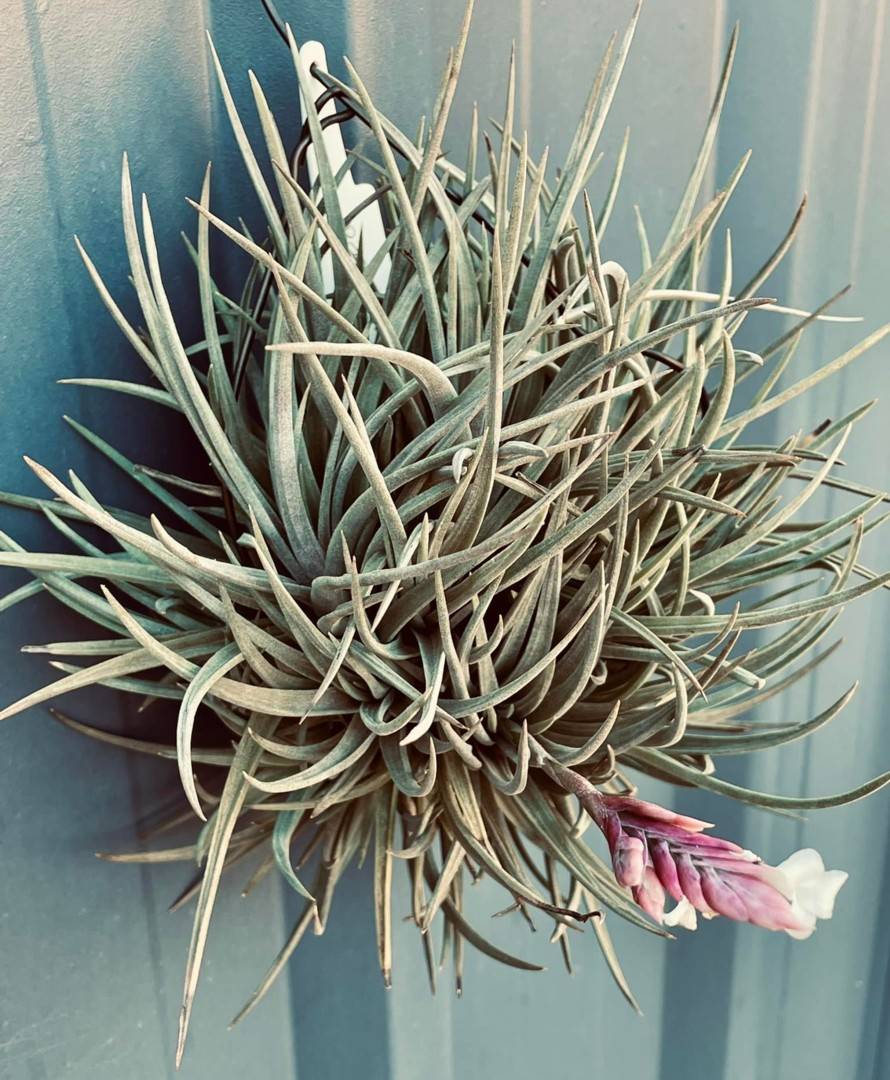
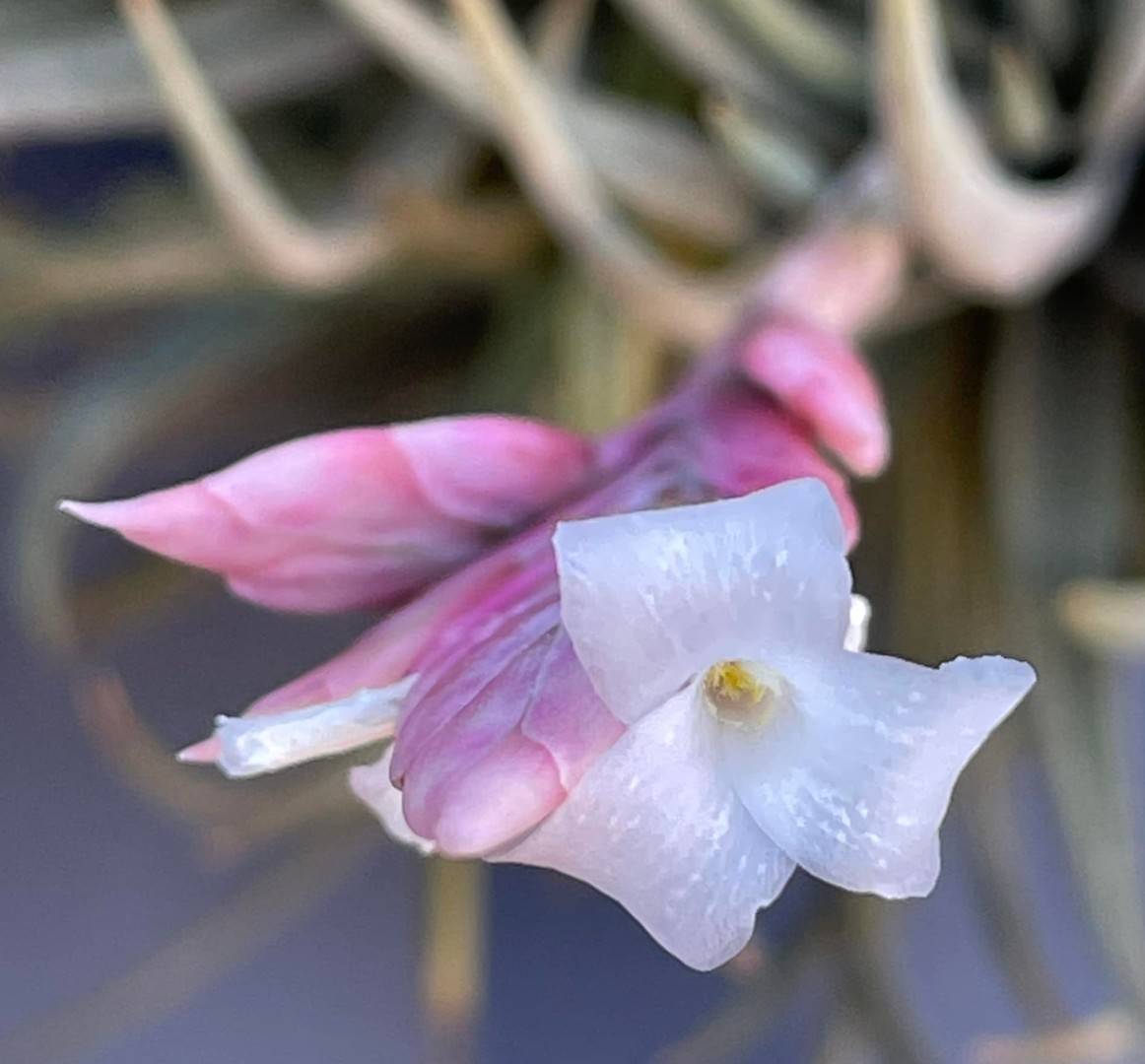
Tillandsia rosacea L. Hrom. & W. Till, Die Brom. 3: 88-90. 2005
A Tillandsia didisticha (E. Morren) Baker indumento foliorum adpresso, foliis flavo-olivaceis apice pungentibus, spicis vix divari¬catis sed densiter erectis et magis stipitatis, internodiis spicarum longioribus purpureoroseisque, glabris, cretaceis, floribus longiori-bus et petalis apice rotundatis crenulatisque differt.
Typus: Bolivia, Depto. Sta. Cruz, in rupibus verticalibus inter pagos Limon et El Porton, 450 m s. m., H. Hromadnik, E. Haugg & W. Till HR 9201 (holo LPB, iso WU), 28.7.1982.
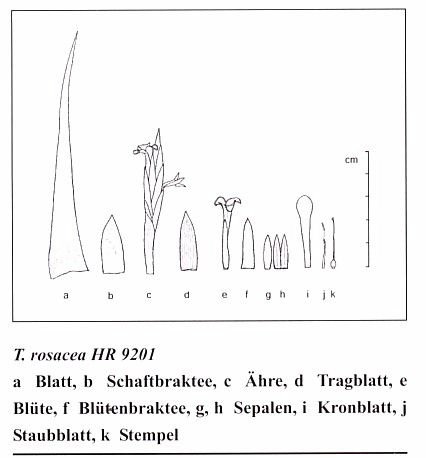
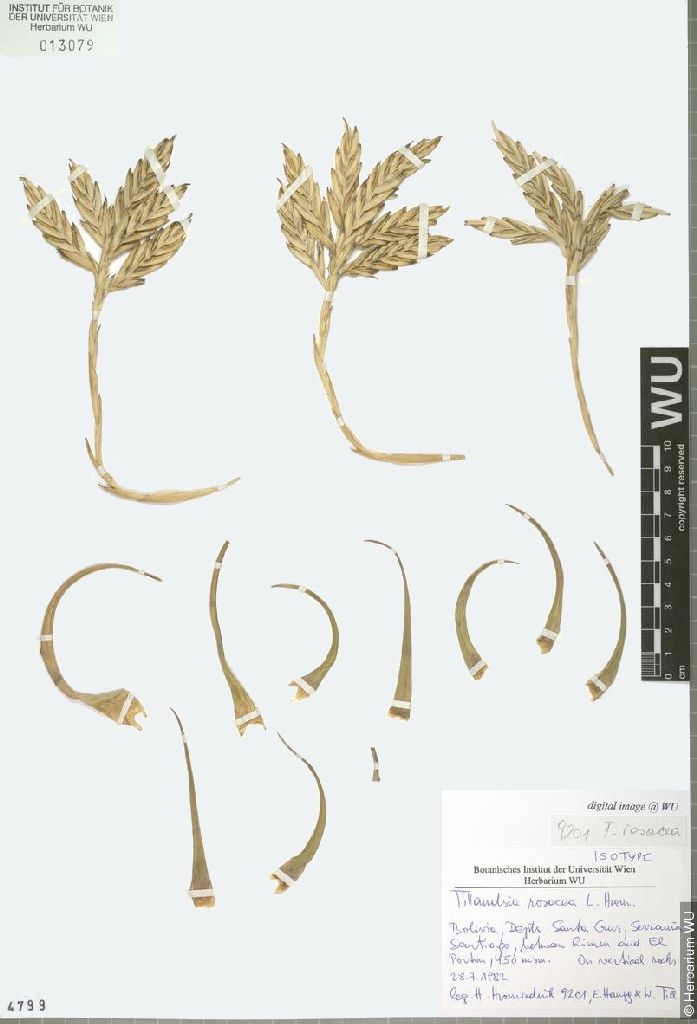
| Lotte Hrondrick |
Herbarium WU |
Translated by Butcher
Plant growing on rocks in small groups, stemless, flowering to about 20 cm high,
Leaves to 10 cm long, usually second, bent upwards and forming a small, 7-10 cm wide rosette,
Leaf sheaths densely imbricate, at the base to 17 mm wide and glabrous, distinguished only from the blade by the light, pale brown scales;
Blade strongly channeled, thick, stiff, tapering to an awl-like, pungent tip;
Scape to 8 cm long, erect, glabrous, smooth, green;
Scape bracts densely imbricate, somewhat exceeding the internodes, lanceolate, to 25 mm long, 10 mm wide, only the lowermost short leaflike tipped, stiff leathery with translucent edges, glabrous, smooth, outside the upper half scattered fine lepidote;
Inflorescence densely bipinnate, 10 cm long, to 35 mm wide, the spikes distichous, erect, only a little and somewhat unequally spreading; axis glabrous, olive green, inter nodes of the inflorescence axis 3-5 mm;
Primary bracts similar to the upper scape bracts, to 26 mm long, 7 mm wide, finely nerved, outside punctulate lepidote, enclosing the spike in the lower section;
Spike complanate, 5- 6,5 cm long, 8 mm wide, long and narrow stemmed, 6-10-flowers, with 1-2 reduced bracts below;
Flowers erect, sessile, 32 mm long;
Flower bracts densely imbricate, narrowly lanceolate, to 22 mm long, 5 mm wide at base, thin leathery, not keeled, glabrous, smooth, post floral somewhat nerved, purple pink, overlaid with white wax, towards the basis olive green;
Rhachis partially visible, glabrous, green, excavated, flexuous, internodes 4-6 mm;
Sepals tip lanceolate, 15 mm long, 3,5 mm wide, smooth, glabrous, equally almost free, thin leathery and with a solid membranaceous edge, the posterior pair weak keeled, pale purple-pink, greenish towards the base;
Petals to over 30 mm long, 2 mm wide at the base, a roundish-oval platte 7 mm wide with bent back wide toothed tip, white;
Stamens 20 mm long and like the pistil enclosed in the flower tube, Filaments narrow ribbonlike, in the upper half pleated many times, white, anthers 3 mm long, filiform, basifixed, olive, Pollen yellow;
Ovary with 2 mm long pedicel, 2,5 mm high, oval, yellowish green; stigma with straight, somewhat spreading lobes.
The plant admittedly reminds you at first glance of T. didisticha (E. Morren) Baker, 1888, but is distinguished in the following numerous characteristics:
The scales are fine and dense appressed, the yellowish olive green shining leaves end in an awl-like pungent tip; the Inflorescence is admittedly just as distichous, the spikes hardly spread, however they are densely erect, and in the lower part pressed together and longer stemmed; the internodes of the axis and flower bracts are longer than T. didisticha, not red and scaled but purple-pink, glabrous and with a shiny wax white overlay; the flowers are longer, the petal with a broad oval platte and a round shaped, toothed bent over tip.
Further similar species are T. pfeufferi Rauh and T. lorentziana Griseb.
The species differs from T. pfeufferi Rauh, 1988, in the compound inflorescence, in all features of the larger flower and the white petals with clearly wide-oval platte.
With T. lorentziana Griseb., 1874, there may be some similarity in the construction of the inflorescence. However the new species clearly differs also from it:
T. rosacea is stemless, and T. lorentziana has an admittedly stocky, but clear stem. The leaves are not flat either and densely prominent silvery lepidote, at the base to 4 cm wide, to 40 cm long and tapering to a narrow tip but hardly 2 cm wide, only to 10 cm long, strongly channeled, rigidly awl like and olive green. The inflorescence is dense, shorter and narrower, the internodes between the erect , much narrower spikes only 3-5 mm long,(with T. lorentziana with its strongly spreading spikes 2-3 cm) the bracts at the sterile base are not equally long but much shorter than the flower bracts.
T. rosacea was found in the Serrania de Santiago, in the lowland of the Province of Santa Cruz in an isolated mountain range that with high-plateaus, precipitous cliffs and rocks, rise up to a height of 1555m from the surrounding area and made from Palaeozoic, sedimentary rocks, 350-500 million years old. T. rosacea was found in large groups on the southern part of a rock-wall.
Summary (by Uwe Scharf)
Nearly 25 years ago a team of collectors found an unidentifiable plant on a steep rock face at an elevation of about 450m in an isolated mountain range in the Bolivian province Sta.-Cruz-de-la-Sierra. It is morphologically similar and probably closely related to T. didisticha (E. Morren) Baker, but differs in that it has very fine scales which are tightly appressed, the leaves are tinged yellow and olive green and end with a pungent tip. The flower spikes are erect and tightly arranged, each bearing a longer sterile part at the base. The internodes of the rhachis and the glabrous, purple pink floral bracts, covered in a white waxy layer are both longer than the red, scaly bracts of T. didisticha. The flowers are also longer than T. didisticha with the upper part of the petals broadly elliptic. The petals have dentate margins in the upper part and a round, reflexed tip.
It differs from T. pfeufferi Rauh in its relatively large, compound inflorescence and in the flower being in all parts bigger.
It differs from T. lorentziana Griseb. by its acaulescent growth, relatively short leaves with involute margins, and a dense, short and narrow inflorescence with more elongate, erect spikes. T. rosacea, the new species, is now described formally herein.
Updated 24/02/22

















